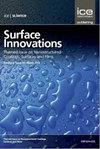Mn(IV)氧化物/Mn(IV)硫化物/聚2-氨基-1-巯基苯在污水光电催化制氢中的应用
IF 3.5
4区 材料科学
Q3 CHEMISTRY, PHYSICAL
引用次数: 0
摘要
通过聚合反应(氧化)制备了Mn(IV)氧化物/Mn(IV)硫化物/聚2-氨基-1-巯基苯(mno2 - mns2 /P2AMB)纳米复合材料,并将其作为污水绿色制氢的高光电催化材料。mno2 -MnS 2 /P2AMB纳米复合材料具有优异的光学性能,其带隙为1.81 eV。为了促进合成的mno2 - mns2 /P2AMB纳米复合光电极的水裂解反应,通过评价电流(J ph),利用污水作为牺牲剂,有效促进氢气的生成。在−0.9 V时,J ph和J o值分别为−0.33和−0.2 mA。相应的,Cm -2。值得注意的是,最佳J ph值为−0.26 mA。在340 nm处观察到入射光子的cm−2,表明更高频率和能量的光导致mno2 -MnS 2 /P2AMB纳米复合材料产生更多的电子和随后的氢气生成。相反,J ph值最低为−0.21 mA。在730 nm处得到cm−2,表明红外波对光电极的影响是由于材料的小带隙(1.86 eV),如前面的分析所计算的那样。这项研究代表了将废水转化为氢气的第一步,氢气可以作为各种工业应用的可持续燃料来源。本文章由计算机程序翻译,如有差异,请以英文原文为准。
Mn(IV) oxide/Mn(IV) sulfide/poly-2-amino-1-mercaptobenzene for green hydrogen generation from sewage water through the photoelectrocatalytic process
The Mn(IV) oxide/Mn(IV) sulfide/poly-2-amino-1-mercaptobenzene (MnO 2 -MnS 2 /P2AMB) nanocomposite is prepared through a polymerization reaction (oxidation) and is utilized as a highly photo-electrocatalytic material for green hydrogen generation from sewage water. The MnO 2 -MnS 2 /P2AMB nanocomposite demonstrates remarkable optical properties, characterized by a bandgap of 1.81 eV. To promote the water splitting reaction by the synthesized MnO 2 -MnS 2 /P2AMB nanocomposite photoelectrode, sewage water is utilized as a sacrificial agent to effectively facilitate the generation of hydrogen gas through the evaluation of the current (J ph ). At −0.9 V, the J ph and J o values are determined to be −0.33 and −0.2 mA.cm -2 , correspondingly. Notably, the optimum J ph value of −0.26 mA.cm −2 is observed for incidence photons at 340 nm, indicating that light with higher frequency and energy leads to the generation of more electrons from the MnO 2 -MnS 2 /P2AMB nanocomposite and subsequent hydrogen production. Conversely, the lowest J ph value of −0.21 mA.cm −2 is obtained at 730 nm, suggesting the influence of infrared waves on the photoelectrode due to the small bandgap (1.86 eV) of the materials, as calculated in a previous analysis. This study represents an initial step towards the conversion of wastewater into hydrogen gas, which can serve as a sustainable fuel source for various industrial applications.
求助全文
通过发布文献求助,成功后即可免费获取论文全文。
去求助
来源期刊

Surface Innovations
CHEMISTRY, PHYSICALMATERIALS SCIENCE, COAT-MATERIALS SCIENCE, COATINGS & FILMS
CiteScore
5.80
自引率
22.90%
发文量
66
期刊介绍:
The material innovations on surfaces, combined with understanding and manipulation of physics and chemistry of functional surfaces and coatings, have exploded in the past decade at an incredibly rapid pace.
Superhydrophobicity, superhydrophlicity, self-cleaning, self-healing, anti-fouling, anti-bacterial, etc., have become important fundamental topics of surface science research community driven by curiosity of physics, chemistry, and biology of interaction phenomenon at surfaces and their enormous potential in practical applications. Materials having controlled-functionality surfaces and coatings are important to the manufacturing of new products for environmental control, liquid manipulation, nanotechnological advances, biomedical engineering, pharmacy, biotechnology, and many others, and are part of the most promising technological innovations of the twenty-first century.
 求助内容:
求助内容: 应助结果提醒方式:
应助结果提醒方式:


